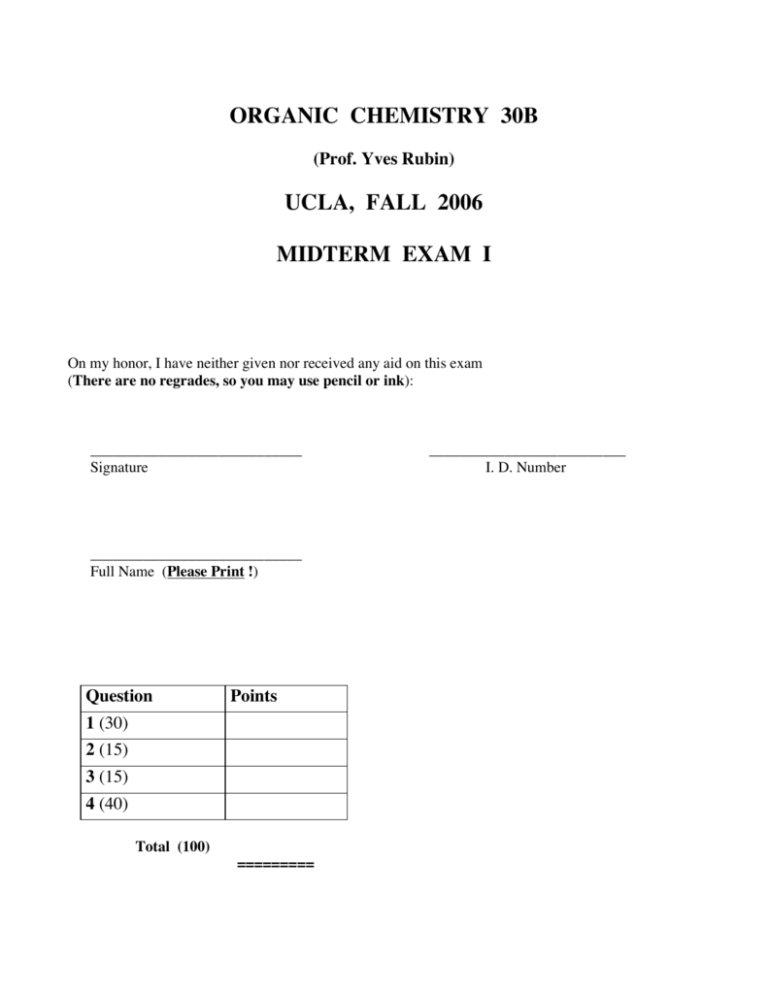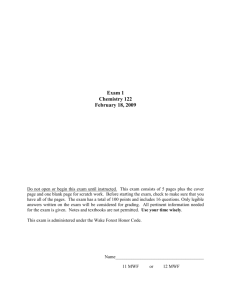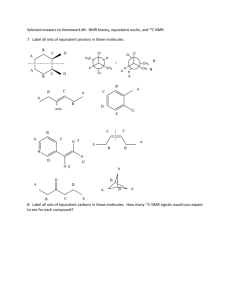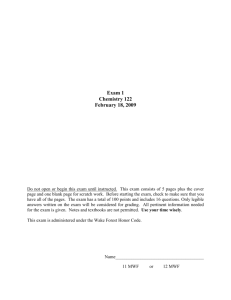ORGANIC CHEMISTRY 30B UCLA, FALL 2006 MIDTERM EXAM I
advertisement

ORGANIC CHEMISTRY 30B (Prof. Yves Rubin) UCLA, FALL 2006 MIDTERM EXAM I On my honor, I have neither given nor received any aid on this exam (There are no regrades, so you may use pencil or ink): ____________________________ Signature ____________________________ Full Name (Please Print !) Question Points 1 (30) 2 (15) 3 (15) 4 (40) Total (100) ========= __________________________ I. D. Number Organic Chemistry 30B Fall 2006 EXAM 1, Page 1 __________________ Name I. SPECTROSCOPY 1. a) (12 points) Give the number of expected signals (ignore splittings) in the 1H and 13C NMR spectra of the following compounds: N 1H NMR: ___________ ___________ ___________ 13C ___________ ___________ ___________ NMR: b) (18 points) Sketch the 1H NMR spectrum for the compound below. Be sure to consider chemical shifts, coupling patterns, and relative intensities between each spin system when drawing your spectrum. Label all non-symmetrically related H’s on the structure (e.g. a,b,c, etc) and show what peak they correspond to on the spectrum: H N H3C O CH3 10 9 8 7 6 (ppm) 5 4 3 2 1 0 Organic Chemistry 30B Fall 2006 EXAM 1, Page 2 __________________ Name 2. (15 points) A compound with molecular formula C3H6O3 has the following 13C NMR spectrum. Assign the signals on the spectrum and provide its structure in the box below: Degree of Unsaturation:__________ Compound C3H6O3 (Assign peaks on or below the spectrum) Organic Chemistry 30B Fall 2006 EXAM 1, Page 3 __________________ Name 3. (15 points) A compound with molecular formula C6N4 has the following IR spectrum. Its 13C NMR spectrum has only two lines. From this information only, deduce its structure and assign any recognizable peak. Keep in mind that the compound is highly symmetric. You MUST provide all the relevant information (peak assignment) to get maximum credit: Degree of Unsaturation:__________ Compound C6N4 IR spectrum: Organic Chemistry 30B Fall 2006 EXAM 1, Page 4 __________________ Name 4. (40 points) A compound has the molecular formula C11H14ClNO. Deduce its structure from the IR, 1H NMR, and 13C NMR spectra given below. You MUST provide all the relevant information (peak assignments) to get maximum credit. Draw the structure in the box provided: Degree of Unsaturation:__________ Compound C11H14ClNO IR (KBr; assign all recognizable IR stretch frequencies): Organic Chemistry 30B Fall 2006 EXAM 1, Page 5 1H __________________ Name NMR: Draw structure here as well and label all non-symmetrically related H’s on the structure (e.g. with a,b,c, etc). Show which peak the labels correspond to on the spectrum by drawing arrows to them. Provide labels for integration values (1H, 2H, 3H) and peak multiplicities (splitting type): Organic Chemistry 30B Fall 2006 EXAM 1, Page 6 13C __________________ Name NMR spectrum for question 4. Draw the structure here again and assign the 13C signals to specific carbons on the structure. However, aliphatic carbons do not need to be assigned, but you should label the alkene or aromatic peaks as such, but not assign them to specific positions since you cannot calculate precise chemical shifts: Tables for IR and NMR data: CHEM 30C, COMMON 1H NMR CHEMICAL SHIFT RANGES Common NMR solvents: CDCl3, D3C–SO–CD3, D2O CD3OD O-CH-O, O-CH-X X-CH-X, Ar-CH-O, etc RCOOH (13-20 ppm) alkene =CH trans: 14-18 Hz cis: 8-10 Hz gem: 1-3 Hz C!CH N-CH aryl =CH O O-CH H H 9 8 CH CH2 CH3 sp3 C-OH, usually broad singlet CO-NH and Ar-OH 10 O 7 6 (ppm) 5 4 3 2 TMS (Me4Si) 1 0 CHEM 30B, COMMON 13C NMR CHEMICAL SHIFT RANGES –C!N N-C RO O OR C C R2C=S (250-280 ppm) O C O-CH3: 50-55 ppm (OMe) O-CH2R: 55-65 ppm (1˚) O-CHR2: 60-75 ppm (2˚) O-CR3: 70-85 ppm (3˚) O C R R' R X (ketone/ (ester/ aldehyde) acid/amide) 200 180 160 aryl/alkene =C– 140 120 100 (ppm) CH CH2 CH3 C!C 80 60 40 TMS (Me4Si) 20 0








